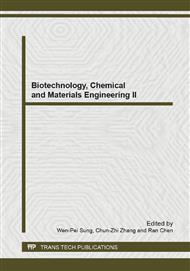[1]
IPCC. Climate Change, The physical scientific basis. Contribution of Working Group I to the Fourth Assessment Report of the Intergovernmental Panel on Climate Change (IPCC), Cambridge University Press, Cambridge, UK, 2007, p.996.
DOI: 10.1017/cbo9781107415416
Google Scholar
[2]
B.J. Kopper and R.L. Lindroth, Responses of trembling aspen (Populus tremuloides) phytochemistry and aspen blotch leafminer (Phyllonorycter tremuloidiella) performance to elevated levels of atmospheric CO2 and O3, Agr. Forest Entomol. 5 (2003).
DOI: 10.1046/j.1461-9563.2003.00158.x
Google Scholar
[3]
S. Xu, X.Y. He, W. Chen, D.L. Tao, W.D. Xu, (2009) Impact of elevated O3 on eco-physiology of trees, Acta Ecol. Sin. 29 (2009) 368-376 (in Chinese).
Google Scholar
[4]
D.F. Karnosky, Impacts of elevated atmospheric CO2 on forest trees and forest ecosystems: knowledge gaps, Environ. Int. 29 (2003) 161-169.
DOI: 10.1016/s0160-4120(02)00159-9
Google Scholar
[5]
T. Lu, X.Y. He, W. Chen, K. Yan, T.H. Zhao, Effects of elevated O3 and/or elevated CO2 on lipid peroxidation and antioxidant systems in Ginkgo biloba leaves, Bull. Environ. Contam. Toxicol., 83 (2009) 92-96.
DOI: 10.1007/s00128-009-9719-3
Google Scholar
[6]
R. Mahalingam, N. Jambunathan, S.K. Gunjan, E. Faustin, H. Weng, P. Ayoubi, Analysis of oxidative signaling induced by ozone in Arabidopsis thaliana,. Plant Cell Environ. 29 (2006) 1357-1371.
DOI: 10.1111/j.1365-3040.2006.01516.x
Google Scholar
[7]
T. Zhao, J. Wang, Y. Wang, Y. Cao, Effects of antioxidant enzymes of ascorbate-glutathione cycle in soybean (Glycine max) leaves exposed to ozone, Adv. Mater. Res. 204-210 (2011) 672-677.
DOI: 10.4028/www.scientific.net/amr.204-210.672
Google Scholar
[8]
K.M. Gillespie, A. Roger, E.A. Ainsworth, Growth at elevated ozone or elevated carbon dioxide concentration alters antioxidant capacity and response to acute oxidative stress in soybean (Glycine max), J. Exp. Bot. 62 (2011) 2667-2678.
DOI: 10.1093/jxb/erq435
Google Scholar
[9]
Y. Ruan, X. He, W. Chen, Z. Chen, Y. Sun, Effects of elevated CO2 concentration on anti-oxidative enzyme activities of urban Pinus tabulaeformis, Chin. J. Ecol., 28 (2009) 839-844.
Google Scholar
[10]
X. Li, X. He, W. Chen, S. Xu, K. Yan, Effects of elevated O3 and CO2 on the antioxidant enzyme activities in Pinus tabulaeformis needles, Chin. J. Ecol. 28 (2009) 2220-2226 (in Chinese).
Google Scholar
[11]
P. Dagmar, R.K. Sairam, G.C. Srivastava, D.V. Singh, Oxidative stress and antioxidant activity as the basis of senescence in maize leaves, Plant Sci. 161(2001) 765-771.
DOI: 10.1016/s0168-9452(01)00462-9
Google Scholar
[12]
J.A. Buege and S.D. Aust, Microsomal lipid peroxidation, Meth. Enzymol. 52 (1978) 302-310.
Google Scholar
[13]
S.P. Mukherjee and M.A. Choudhuri, Implications of water stress-induced changes in the levels of endogenous ascorbic acid and hydrogen peroxide in Vigna seedlings, Physiol. Plant 58 (1983) 166-170.
DOI: 10.1111/j.1399-3054.1983.tb04162.x
Google Scholar
[14]
W.F. Beyer and I. Fridovich, Assaying for superoxide dismutase activity: some large consequences of minor changes in conditions, Anal. Biochem. 161 (1987) 559-566.
DOI: 10.1016/0003-2697(87)90489-1
Google Scholar
[15]
H. Aebi and P. Lester, Catalase in vitro, Meth. Enzymol. 105 (1984) 121-126.
Google Scholar
[16]
G.X. Chen and K. Asada, Ascorbate peroxidase in tea leaves: occurrence of two isozymes and the differences in their enzymatic and molecular properties, Plant Cell Physiol. 30 (1989) 987-998.
DOI: 10.1093/oxfordjournals.pcp.a077844
Google Scholar


